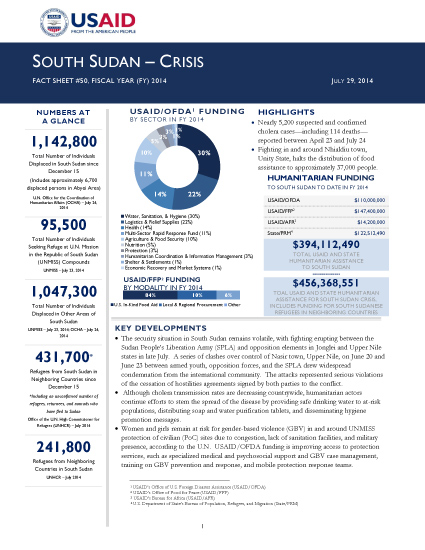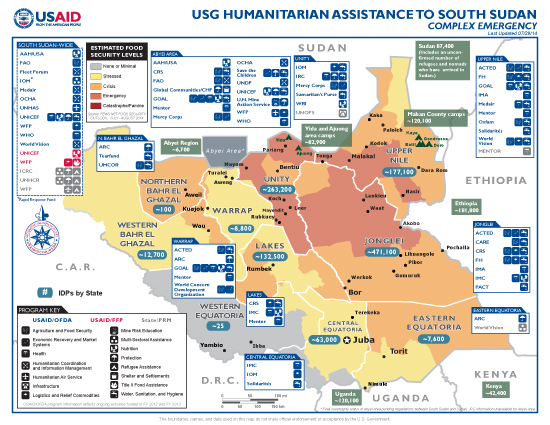- What We Do
- Agriculture and Food Security
- Democracy, Human Rights and Governance
- Economic Growth and Trade
- Education
- Environment and Global Climate Change
- Gender Equality and Women's Empowerment
- Global Health
- Humanitarian Assistance
- Transformation at USAID
- Water and Sanitation
- Working in Crises and Conflict
- U.S. Global Development Lab
Speeches Shim
July 29, 2014
Numbers At A Glance
1,142,800
95,500
1,047,300
431,700
241,800
Humanitarian Funding:
To South Sudan To Date In FY2014:
| USAID/OFDA | $110,000,000 |
| USAID/FFP | $147,400,000 |
| USAID/AFR | $14,200,000 |
| State/PRM | $122,512,490 |
| TOTAL | $394,112,490 |
Highlights
Nearly 5,200 suspected and confirmed cholera cases—including 114 deaths— reported between April 23 and July 24
Fighting in and around Nhialdiu town, Unity State, halts the distribution of food assistance to approximately 37,000 people.
KEY DEVELOPMENTS
The security situation in South Sudan remains volatile, with fighting erupting between the Sudan People’s Liberation Army (SPLA) and opposition elements in Jonglei and Upper Nile states in late July. A series of clashes over control of Nasir town, Upper Nile, on June 20 and June 23 between armed youth, opposition forces, and the SPLA drew widespread condemnation from the international community. The attacks represented serious violations of the cessation of hostilities agreements signed by both parties to the conflict.
Although cholera transmission rates are decreasing countrywide, humanitarian actors continue efforts to stem the spread of the disease by providing safe drinking water to at-risk populations, distributing soap and water purification tablets, and disseminating hygiene promotion messages.
Women and girls remain at risk for gender-based violence (GBV) in and around UNMISS protection of civilian (PoC) sites due to congestion, lack of sanitation facilities, and military presence, according to the U.N. USAID/OFDA funding is improving access to protection services, such as specialized medical and psychosocial support and GBV case management, training on GBV prevention and response, and mobile protection response teams.
INSECURITY, DISPLACEMENT, AND ACCESS CONSTRAINTS
Clashes and food insecurity in South Sudan since December 15 have displaced nearly 1.6 million people, according to the U.N. Of the total, more than 1.1 million people are internally displaced, and approximately 431,700 people have sought refuge in neighboring countries.
Although relief actors continue to scale up interventions in hard-to-reach areas, access challenges continue to hinder humanitarian assistance to populations in need. Fighting in northern Unity on July 15 forced a U.N. World Food Program (WFP) team to halt operations and evacuate Nhialdiu town, located approximately 18 kilometers (km) from Bentiu town, Unity, interrupting a food distribution for approximately 37,000 people. According to local media, fighting resulted in the death of at least 30 civilians and wounded approximately 50 others.
On July 20, fighting erupted between the SPLA and opposition elements in Nasir, drawing condemnation from the international community including the African Union, the U.N. and the U.S. Government (USG). The attack by opposition forces represents the first major attack since the Government of the Republic of South Sudan (GoRSS) and the opposition recommitted to a cessation of hostilities on June 10, according to the U.N. The humanitarian impact of the recent fighting was limited, as the majority of the civilian population had already vacated the town during previous rounds of fighting earlier in 2014.
The main rainy season in South Sudan continues to result in poor road conditions in many areas of the country, with most major roads impassable, the U.N. reports. Due to weather-related access constraints, humanitarian actors are scaling up the capacity to transport relief commodities via air and river routes.
HUMANITARIAN NEEDS ASSESSMENTS AND RESPONSE ACTIVITIES
Rapid response teams continue to provide assistance to food insecure populations in hard-to-reach areas of Jonglei, Unity, and Upper Nile. As of July 24, U.N.-led rapid response mechanisms had reached nearly 805,000 people in remote locations since March—representing a 9 percent increase in the number of people assisted since July 10.
Humanitarian actors completed a rapid needs assessment in Jonglei’s Pigi County, where an estimated 89,000 people are sheltering, according to the U.N. The assessment team identified urgent food, health care, and livelihoods needs among both the internally displaced person (IDP) and host community populations. Relief agencies are coordinating response activities.
As of July 22, the U.N. Children’s Fund (UNICEF) had reached more than 80,000 children with humanitarian assistance—including screening approximately 50,000 children for malnutrition and referring more than 2,000 children for treatment for malnutrition—in Jonglei, Unity, and Upper Nile, through the interagency rapid response mechanism.
South Sudan Crisis Fact Sheet #50 July 29, 2014 ![]() (pdf - 304k)
(pdf - 304k)
South Sudan Crisis Map, July 29, 2014 ![]() (pdf - 1 MB)
(pdf - 1 MB)
CAMP COORDINATION AND CAMP MANAGEMENT
To address difficult living conditions at PoC sites, relief actors continue to improve existing PoC infrastructure and assist the voluntary relocation of IDPs to new PoC areas better suited to host IDPs during the rainy season. As of July 22, more than 3,500 IDPs had relocated from the UNMISS Tomping base to the new U.N. House PoC 3 site in Juba town, Central Equatoria State. Approximately 11,500 IDPs had moved into the new PoC area in Malakal, Upper Nile, as of July 21, according to the International Organization for Migration (IOM). In addition, engineering work at the new PoC site for IDPs in Bor town, Jonglei, is ongoing, as well as the relocation of the base’s total IDP population of more than 4,100 people. The upgraded new site is designed to host up to 8,000 people as a contingency measure.
AGRICULTURE, FOOD SECURITY, AND NUTRITION
Malnutrition remains a serious concern in South Sudan, with the U.N. projecting that 235,000 children countrywide will require treatment for severe acute malnutrition (SAM) in 2014, twice as many as in 2013, the U.N. reports. Nutrition actors conducted a mass mid-upper arm circumference screening of approximately 2,900 children under five years of age at the Malakal PoC on July 7, finding 4.1 percent SAM and 8.2 percent moderate acute malnutrition levels. Together, the figures result in a global acute malnutrition (GAM) level of 12.3 percent—within the U.N. World Health Organization (WHO) serious threshold for GAM levels in emergencies.
Relief agencies, including Médecins Sans Frontières (MSF), continue to respond to increasing levels of malnutrition in South Sudan. Between January and mid-July, MSF feeding programs countrywide had admitted more than 13,300 children—most under five years of age. The figure amounts to 73 percent of the 18,100 children admitted to MSF programs during the same time period in 2013. In Leer County, Unity, MSF teams were treating approximately 40 malnourished children per month prior to the current crisis, whereas MSF teams are now treating approximately 1,000 malnourished children per month.
USAID/OFDA partner Food for the Hungry (FH) continues to conduct critical agriculture and food security activities to meet the needs of more than 9,000 conflict-affected households in South Sudan. With USAID/OFDA support, FH is distributing beans, groundnuts, maize, sorghum, fast-maturing vegetable seeds, and agricultural tools, to vulnerable families. To date in FY 2014, USAID/OFDA has provided nearly $560,000 to FH to improve food security in Jonglei and Upper Nile.
HEALTH AND WASH
As of July 27, health actors had reported nearly 5,300 suspected and confirmed cases of cholera—including 115 deaths—in South Sudan, with approximately 60 percent of total cases reported outside of Juba County, including nearly 2,000 cases in Eastern Equatoria State. Despite decreased transmission rates countrywide, humanitarian actors continue to take action to mitigate the spread of cholera—particularly in areas outside of Juba County—by providing safe drinking water to at-risk populations, distributing soap and water purification tablets, and disseminating hygiene promotion messages.
Health actors remain concerned regarding the potential spread of the Hepatitis E virus in and around Mingakman town, Lakes State, where more than 60 cases and four deaths were reported as of June 13. Health actors are encouraging the GoRSS Ministry of Health to declare an outbreak in the area, while humanitarian agencies continue to scale up water, sanitation, and hygiene (WASH) interventions in the areas where IDPs are sheltering. For example, relief agencies are supporting information dissemination through house-to-house visits and radio talk shows.
Since the beginning of the crisis in December 2013, relief actors have reached approximately 2.4 million people with emergency WASH assistance, the U.N. reports. Activities have included the rehabilitation of boreholes and water trucking to increase access to safe drinking water; the construction of emergency latrines and hand-washing stations; and the distribution of water containers, water purification tables, and soap.
PROTECTION
UNICEF—the lead actor for GBV prevention and response in Upper Nile—is working with UNMISS and humanitarian actors to improve safety and security in the Malakal PoC site and surrounding areas. Women and girls remain at risk for sexual violence and other forms of GBV in and outside of PoC sites due to congestion, lack of adequate sanitation facilities, and heavy military presence, according to the U.N.
UNICEF and relief actors are providing health services and psychosocial support to survivors of GBV, as well as supporting community outreach services. Relief actors pre-positioned 15 UNICEF-procured post-exposure prophylaxis kits—short-term antiretroviral treatment to reduce the likelihood of HIV/AIDS infection after potential exposure—in the Malakal PoC site to ensure timely support to survivors of GBV.
USAID/OFDA funding is helping address protection needs by providing conflict-affected individuals with access to protection services, such as access to specialized medical and psychosocial support and GBV case management, training individuals in GBV prevention and response, and supporting mobile protection response teams.
LOGISTICS AND RELIEF COMMODITIES
On July 18 and 19, the remaining two barges in a four-barge convoy departed Juba town for Upper Nile following the repair of a pusher required to move the barges. However, additional technical difficulties forced the barges to halt approximately 15 km north of Juba, according to the U.N. The four barges are carrying approximately 1,200 metric tons (MT) of WFP food commodities for populations in Upper Nile’s Malakal and Melut towns. The U.N. is actively working to address the issues to begin movement of the barges as soon as possible.
Between January 1 and July 21, WFP logistics dispatched approximately 106,000 MT of food commodities to populations in South Sudan. Of the total, WFP airlifted or airdropped approximately 16,500 MT—sufficient to provide approximately 990,000 people with a full, one-month ration, or 495,000 people with a full, two-month ration—from within South Sudan and from Ethiopia.
Humanitarian actors are contracting additional air assets to increase response capacity in South Sudan. The Logistics Cluster—the coordinating body for humanitarian logistics activities, comprising U.N. agencies, non-governmental organizations, and other stakeholders—has acquired one additional aircraft to facilitate the transport of WASH and health supplies to Malakal and Wau Shilluk towns, Upper Nile, to support the cholera response. The Logistics Cluster also recently contracted an additional aircraft to transport 10 MT of humanitarian cargo to Bentiu per day. The addition will free up other air assets for rapid response operations, the U.N. reports.
OTHER HUMANITARIAN ASSISTANCE
To date, international donors have provided more than $902 million—approximately 50 percent of the $1.8 billion total requested funding—to support humanitarian activities through the revised South Sudan Crisis Response Plan.
On July 24, the European Commission’s Directorate-General for Humanitarian Aid and Civil Protection (ECHO) announced €14 million—approximately $18.9 million—in additional support to WFP for the South Sudan crisis. The funding will support logistics operations and the distribution of much-needed food assistance and vouchers to approximately 1.7 million people. Approximately $5 million of the total contribution will support the transportation of humanitarian cargo, according to ECHO. As of July 24, ECHO had provided approximately $104.4 million in 2014 support for the humanitarian response in South Sudan.



Comment
Make a general inquiry or suggest an improvement.